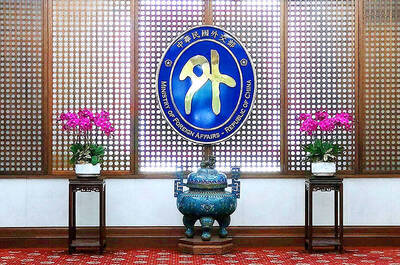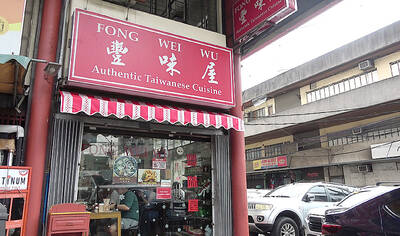Former president Chen Shui-bian (陳水扁) yesterday urged President Ma Ying-jeou (馬英九) to stop China’s top negotiator from coming to Taiwan for further negotiations if Beijing does not agree to Taiwan having its own interpretation of “one China.”
Chen’s office issued a statement demanding Ma keep his promise that Taiwan would not engage in any talks with China if Beijing did not agree to Taiwan having its own interpretation of “one China.”
Chen said Ma made the remarks when they met at the Taipei Guest House on April 1 this year.
“I would like to know which Chinese leader over the past five months has said that Taiwan can have its own interpretation of ‘one China,’” Chen said. “The only consensus of the so-called ‘1992 consensus’ is ‘one China’ and there has never been room for a different interpretation of what that means. Why does President Ma want to deceive himself and the people of Taiwan?”
Whether “one China” can be interpreted differently by each side of the Taiwan Strait must be clearly stated, Chen said, and Taiwan’s national sovereignty must not be lost in word games.
Chen said his experience handling cross-strait affairs over the eight years of his presidency had led him to believe that the so-called “1992 consensus” was nothing but a “lie” and a “hoax,” because it was a term created by then Mainland Affairs Council chairman Su Chi (蘇起) in April 2000 after both sides’ top negotiators met in Hong Kong in 1992. Su and then Straits Exchange Foundation (SEF) chairman Koo Chen-fu (辜振甫), as well as former SEF secretary-general Shi Hwei-yow (�?�), have since denied the existence of the so-called “1992 consensus,” Chen said.
The so-called “1992 consensus” is a “one China consensus,” Chen said, adding that the official document published by the Association for Relations Across the Taiwan Strait (ARATS) clearly states that “one China” cannot be “interpreted differently.”
If “one China” could be interpreted differently, Chen said, there would be two Chinas, but it cannot, so it is a “one China consensus.”
In other words, to accept the so-called “1992 consensus” is to admit that Taiwan is part of China, a province or a regional government of the People’s Republic of China, Chen said.
The so-called “1992 consensus” is the “unification guidelines” of the Chinese Nationalist Party (KMT), Chen said.
Chen blamed the National Unification Council, National Unification Guidelines and all the related interpretations of “one China” during former president Lee Teng-hui’s (李登輝) term as the source of controversy surrounding the so-called “1992 consensus.”
Since the then KMT government did not reject Su’s “consensus” in 2000, Chen said, the “1992 consensus” became the simplified form of unification guidelines, adding that not until his presidency did the government firmly reject the term and the concept.
Chen said the so-called “1992 consensus” is a contract to sell out the Taiwanese people. To accept it is to accept the “one China” principle and abandon Taiwan’s status as an independent sovereignty, he said.
“Only the 23 million people of Taiwan have the right to decide the future of Taiwan,” he said. “If we forsake Taiwan’s sovereignty, we will become a second Hong Kong or Macau.”

The Ministry of Foreign Affairs (MOFA) yesterday voiced dissatisfaction with the Comprehensive and Progressive Agreement for Trans- Pacific Partnership (CPTPP), whose latest meeting, concluded earlier the same day, appeared not to address the country’s application. In a statement, MOFA said the CPTPP commission had "once again failed to fairly process Taiwan’s application," attributing the inaction to the bloc’s "succumbing to political pressure," without elaborating. Taiwan submitted its CPTPP application under the name "Separate Customs Territory of Taiwan, Penghu, Kinmen and Matsu" on Sept. 22, 2021 -- less than a week after China

ALIGNED THINKING: Taiwan and Japan have a mutual interest in trade, culture and engineering, and can work together for stability, Cho Jung-tai said Taiwan and Japan are two like-minded countries willing to work together to form a “safety barrier” in the Indo-Pacific region, Premier Cho Jung-tai (卓榮泰) yesterday said at the opening ceremony of the 35th Taiwan-Japan Modern Engineering and Technology Symposium in Taipei. Taiwan and Japan are close geographically and closer emotionally, he added. Citing the overflowing of a barrier lake in the Mataian River (馬太鞍溪) in September, Cho said the submersible water level sensors given by Japan during the disaster helped Taiwan monitor the lake’s water levels more accurately. Japan also provided a lot of vaccines early in the outbreak of the COVID-19 pandemic,

THE GOOD WORD: More than 100 colleges on both sides of the Pacific will work together to bring students to Taiwan so they can learn Mandarin where it is spoken A total of 102 universities from Taiwan and the US are collaborating in a push to promote Taiwan as the first-choice place to learn Mandarin, with seven Mandarin learning centers stood up in the US to train and support teachers, the Foundation for International Cooperation in Higher Education of Taiwan (FICHET) said. At the annual convention of the American Council on the Teaching of Foreign Languages held over the weekend in New Orleans, Louisiana, a Taiwan Pavilion was jointly run by 17 representative teams from the FICHET, the Overseas Community Affairs Council, the Steering Committee for the Test of Proficiency-Huayu, the

A home-style restaurant opened by a Taiwanese woman in Quezon City in Metro Manila has been featured in the first-ever Michelin Guide honoring exceptional restaurants in the Philippines. The restaurant, Fong Wei Wu (豐味屋), was one of 74 eateries to receive a “Michelin Selected” honor in the guide, while one restaurant received two Michelin stars, eight received one star and 25 were awarded a “Bib Gourmand.” The guide, which was limited to restaurants in Metro Manila and Cebu, was published on Oct. 30. In an interview, Feng Wei Wu’s owner and chef, Linda, said that as a restaurateur in her 60s, receiving an